Chronology (cribbing shamelessly from trw99’s research and Roy Frossberg but adding some things):
http://www.answers.com/Q/Where_can_you_f...on_serial_153461786 - Joseph Charles Reilly was born in 1786 in Granard, Co Longford, Ireland. At some time he moved to London.
1812, he married Martha Barkley (b.1787 in London) on 17 May 1812. They had a daughter, Elinor, and in a son, Edward Michael.
1814-1835 - he opened a business as a "jeweller" (goldsmith or silver plate - not sure) at 12 Middle Row, Holborn Bars and, as was common with jewelers in those days, he also part-exchanged, bought and sold guns.
He held the Tenancy on this building from 1814 to 1835. (there is an engraving of this building from the Illustrated London News dated 1867. JC Reilly's presence at 12 Middle Row is confirmed by property records and London voting lists.
Note: I'm going to speculate. In the early 19th century Joseph Manton had raised gun making to an art form with elaborate engraving etc. I speculate that Reilly received guns from the Lawyers and country gentlemen around him to engrave...and this got him into the business...and that he began to market first pistols then went from there).
"Early in the present century, Messrs. Reily, gun makers, were established near Chancery Lane, in Holborn, where they enjoyed the patronage of members of the legal profession, besides an extensive country (gentry) connection Their premises were extensive, and afforded every facility for carrying on a large business. They adhered to the principle, that “It is not sufficient that an article be cheap; it must also bear the test of excellence.” (quotes from Wyman’s Commercial Encyclopedia) (1888).
J C Reilly guns were sometimes engraved "Holborn Bars”.
Note: "Holborn Bars" likely refers to guns made at 12 Middle Row. This quote is interesting because it explains his connections: “Holborn was anciently of much consequence, not only on account of the many eminent people who resided here but because of the Inns of the Court (note: "lawyers") which graced both its north and south sides.”.” Holborn Bars used to stand a little west” … (Bar is a tax collection site…a road toll…there were six leading into London at the time on this road).
Inns of the court at Holborn, then and now:
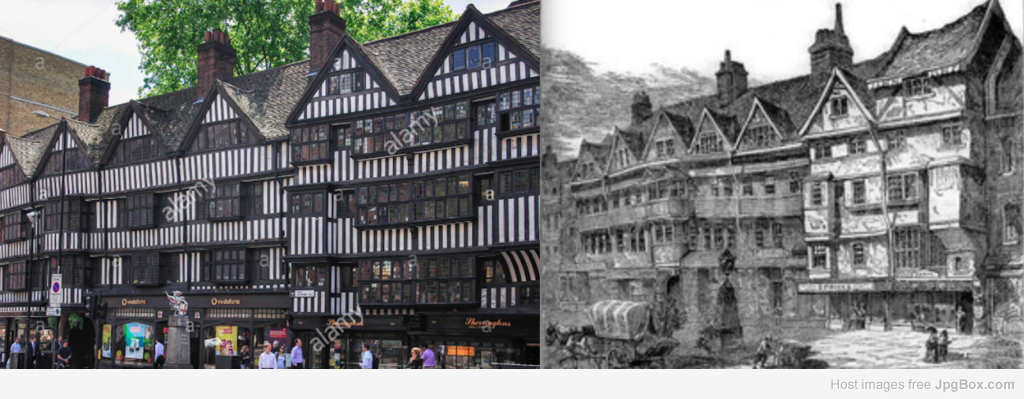
See this site for a description of Chancery Lane and Holborn Bars and a woodcut.
http://www.british-history.ac.uk/old-new-london/vol2/pp526-542Interpretation of the Woodcut with location of Reilly's store per a map on Ancestry.com:
 Note in the engraving on the top of Middle Row that stuck out into and blocked the street; Reilly's store was there. Sign says "Holborn Bars." "Inns of the Court" in the background.
Note in the engraving on the top of Middle Row that stuck out into and blocked the street; Reilly's store was there. Sign says "Holborn Bars." "Inns of the Court" in the background.
1816 - Edward Michael Reilly born to Joseph Charles.
1819 - He entered a maker’s mark at Goldsmiths Hall in 1819 as a plateworker from 12 Middle Row, Holborn. (Note: I've been unable to verify this; there is a John C. Reilly from 1818-20 with a silver maker's mark; Plate would seem to indicate he worked in silver. Every goldsmith's mark is registered but I have difficulty navigating the site. Somebody in London might research this.)
1831 - The Times newspaper of 5th January 1831 reported a burglary on the 1st of January at the same address, the premises of J C Reilly, gun maker and silversmith. The value of property stolen was estimated at ÂŁ150.
1834 - Note: Cannot find Reilly advertisements for guns in London newspapers before about 1834….here are two and they seem to concentrate on pistols:
-- London Morning Chronicle, 1 Sep 1834: GUNS AND PISTOLS.-J. C. REILLY has acquired an excellent assortment of SECOND HAND GUNS, chiefly In exchiange, for less than half their value…..
-- London Morning Chronicle, 15 Dec 1834: GUNS and PISTOLS.-J. C. REILLY is desirous of DISPOSING of an accumulation of' SECOND- HAND GUNS, received in exchange, at about one-third the original price…
1835 – 1847 -
1835 – 1847: JOSEPH CHARLES REILLY (known also as J C REILLY) was in business as a gunmaker at
316 High Holborn, London.
Any Reilly with the High Holborn address must be 1835 to 1847 (Note: Several sources claim 316 High Holborn allegedly was the old premises of Joseph Manton; But Wikipedia reports Manton went bankrupt in 1826 and his shop on “Oxford street” was seized and his entire stock of guns were sold to Joseph Lang. He revived his firm temporarily 1827-28 it too fell into debt, and he spent 1828-29 in debtors prison - He died Jun 1835; Other sources claim Manton’s shop was on Dover Street in Holborn. So more sources are needed to support this assertation - unless Manton occupied 316 High Holborn during his attempt to revive his firm and stayed there till his death in 1835). Here are addresses for Manton per a manufacture of reproduction labels:
Joseph Manton
Davies Street, Berkeley Square, London
1795 - 1805
John Manton
6 Dover Street, London
1801 - 1815
Joseph Manton
11 Hanover Square, London
1812 - 1820
Joseph Manton
Marylebone Park House, New Road, London
1828
--
Morning Chronicle, London, 14 Aug 1835: REMOVING.- JOSEPH CHARLES REILLY will be removing at the end of this month, to the spacious premises, 316, High Hoiborn, near Chancery-lane,
1835-47: There are hundreds of advertisements by JC Reilly in various London periodicals..almost daily.. including this one from London Evening Standard, 1 February 1839: “Pistols of every description, and a large Stock of Second-hand Guns by the Mantons, Purdey, Forsyth, &c. at half price. REILLY, 316, High Holborn, near Chancery-lane.”
See: http://www.genesreunited.co.za/searchbna/results?memberlastsubclass=none&searchhistorykey=0&keywords=reilly&county=london%2C%20england&from=1830&to=1839&type=advertisement&page=1
1838 - Name/Store: Reilly, Joseph Charles, gunmaker; 316 Chancery St., 8. High Holborn, Division II Holborn Bars, London; (John Tallis’s London Street Views, London Shops and Businesses 1838-1840)
1840 : Name: J C REILLY at 316 High Holborn mentioned as a ‘gunmaker’ in Blaine’s Rural Sports
1841 - Name: Joined by his son, Edward Michael as a partner; the 1841 census listed Edward as "Gunmaker." (Some reports claim that EM joined his father in the business in 1835 on the move to High Holborn, age of 19, which seem plausible at least as a trainee, possibly not as a partner).
1841 - In the 1841 census Joseph and his family were recorded at "Holborn (above the Bars)", both Joseph and Edward described themselves as gun makers.
1841 : Name: JOSEPH REILLY is mentioned in the poem ‘Shooting’ by Alexander Webber, published in this year.
1847 - Store: Opened 502 Oxford; See Reilly SN 8463. St.; aka New Oxford Street, London. A history of Reilly claims that EM Reilly kept his father's system of consecutive Serial Numbers when Oxford St. Opened and that he began with SN 8400 and by 1880 had reached about 20,000. I can find no evidence he cited, but from the below analysis and list of SN's, the author knew what he was talking about.
The opening of this store was likely in late March 1847…see below:
-- “The lease of these premises (Holborn) expired in 1847. The new road from Holborn to Oxford Street had just been opened affording an opportunity to obtain a new building situated in a fine central position, the leading approach fro the City to the extreme west end of London.” (Wyman)
--
London Morning Post, 13 Mar 1847: “GUNS, PISTOLS, and RIFLES.— REILLY, Gunmaker, 316, Holborn, near Chancery-lane.—
The Lease of these premises will expire at Thursday next, and he is RE- MOVING to 502, New Oxford Street”
-- See: London Daily News, 23 April 1847. “BLISSETT, gunmaker (formerly Reilly's), 316, High Holborn, near Chancery-lane.”
--
London Daily News, 30 Oct 1847: “Pistols of every description. Gentlemen going abroad, officers, and cadets, will find all their requirements anticipated in REILLY'S extensive Stock; New and Second-hand', 502, New Oxford-street,
removed from Holborn. FRANCE, SWITZERLAND, ITALY. CONTINENTAL.”
Label on the case of 8464 i.e. "
Removed from Holborn":
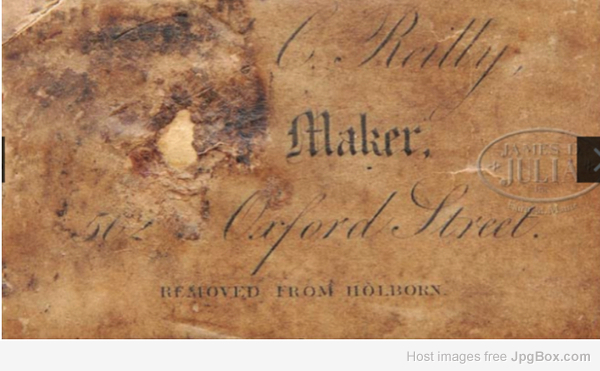
Print of 502 Oxford St. from a label in a case:
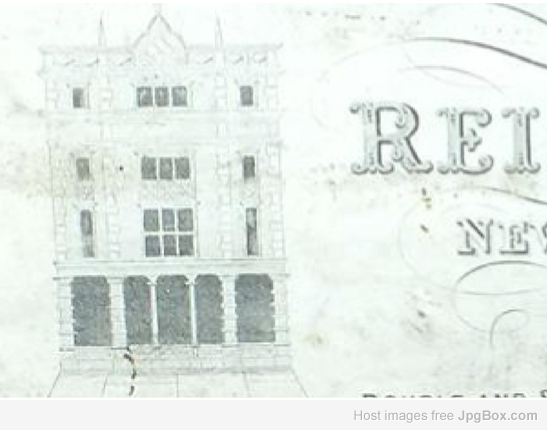
502 (16) Oxford Street today:
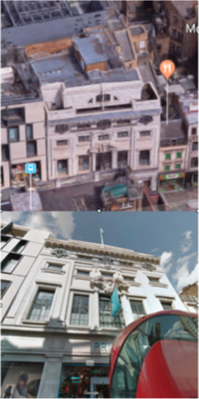
1850 : Book: E M REILLY published his ‘Treatise on Air Guns’ Trade labels advertised ‘Air Canes for Sale’
1851 - Exhibition: London Great Exhibition E M REILLY of Oxford Street exhibited guns (not just air guns either) at the Great Exhibition. He was known to have been influenced by the breechloaders shown by Lefaucheaux of Paris and was ‘overdone with orders’. the Reillys together with Joseph Lang and John Blanch were the best known promoters of centre-fire guns after the 1851 Great Exhibition (see below catalogue).
Great Exhibition catalogue entry #237 (right below #236 Rigby): “Reilly, E.M. New Oxford St.; Manu — Improved guns, rifles, pistols, air guns, etc. (comment" J.C. is not mentioned in this catalogue).
“Messrs. Reilly first exhibited the now popular “Breech-Loaders” in the World’s Fair of 1851, but the sporting public had not then discovered the great advantages of the system. About this period or a few years later, Messrs. Reilly received favorable reports of their breech-loaders from a few unprejudiced sportsmen. “The quickness of loading is wonderful; the new gun kills as well as my old ones.” (Wyman)
1851 - British Army trials which picked the .577 Enfield as standard rifle, adopted in 1853. Any Enfields built by Reilly must post date 1853.
1854 - Advertisement; Reilly, Joseph Charles, 502, Oxford Street. Reilly, Edward Michael, 502, Oxford
1854 - Advertisement: Reilly: selling self-cocking Tranter revolvers on the Adams Patent.
1855 - Exhibit: Messrs Reilly were exhibitors at the Paris exhibition of 1855 and their display “attracted considerable notice and valuable patronage.” All the goods were sold and many orders booked.
1855 - Fredrick Prince's breech loading patent - (see Reilly SN 10782 & 11645); Fredrick Prince's .577 percussion breach loading rifle. outshot the just adopted Enfield 1853 in trials in 1855. 1859 several gun makers petitioned the Board of Ordnance to reconsider their decision. Reilly was marketing this gun and is so mentioned in the below historical site. He always had the most modern breech loaders in his shop. History:
http://www.historicalfirearms.info/post/130153944059/historicalfirearms-frederick-princes1855 - Beaumont-Adams patent; (see B 7452 - probably not a Reilly SN).
1858 - Advertisements in London Travel literature carry the name "Reilly, 502 New Oxford Street, London
1858 - Field Trial: breechloader v muzzleloader trials with [amongst others] Lancaster, Needham and Lang. Placed tenth in a trial of ’58 and eleventh in ’59.
1858 - Guns: Produced rifles on the C E Green & J Green patent – a ‘capping breech loader’ that had a rudimentary cartridge ignited by an external cap fired by a conventional side hammer.
1858 - Advertisement: Address used was
“Reilly, Gun Maker, 502 New Oxford Street, London”
http://www.gracesguide.co.uk/File:Im1858POCum-Reilly.jpg
1859 - Opened a branch store at 315 New Oxford Street aka 315 Oxford Street, London. (see Reilly SN 12079). J.C. Reilly used “Reilly & Co.” (believe JC had retired he was 74 years old; he died 1864). Edward sold guns labeled 502 Oxford street as Edward M. Reilly & Co.
(interesting that in 1844, Issac Riviere was listed as a gun maker at 315 Oxford street per a list of London gun makers) (Riviere had considerable influence over the design of precussion pistols and patented his own lock in 1825; he died in 1851)
https://books.google.com/books?id=OZxeAA...rn&f=false- - see advertisement below - left is 1858 (no 315), right is 1859 (with 315 + shooting galleries).
1859 - Advertisement:
first use of “E.M. Reilly? First noted use of 315 Oxford Street address.
http://www.gracesguide.co.uk/File:Im1859PODor-Reilly.jpg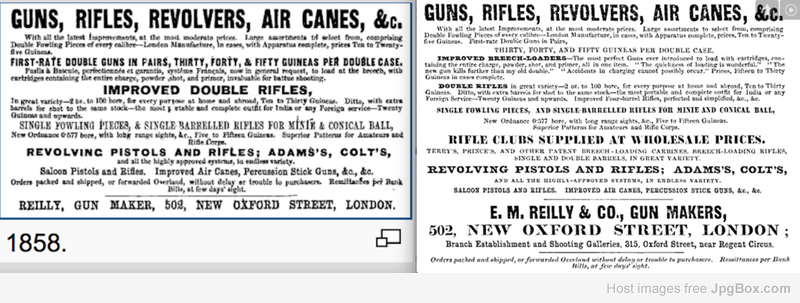
Note Prices quoted in Guineas: From Wikipedia: "Even after the coin ceased to circulated (1816), the name guinea was long used to indicate the amount of 21 shillings (Ł1.05 in decimalised currency). The guinea had an aristocratic overtone; professional fees and payment for land, horses, art, bespoke tailoring, furniture and other luxury items were often quoted in guineas until a couple of years after decimalisation in 1971." A cased Reilly breechloader in 1859 was 15-30 Guineas. Assuming $4.50 per Guinea at exchange rate at that time, a Reilly could have cost between about $70 and $130, a lot of money in those days.
1859 - London Field Trial; Reilly entered the British 1859 Field Trials with a 15 bore breech-loader built on the Lefaucheux system. Placed 11th. It was highly praised by the editors of “Field” magazine.
1859 - Patent: Henry Jones' patent #2040 was granted September 7, 1859.
1860 - Patent: C.E and J. Green, Provisional Patent (bolt action system)
1862 - Patent: Green Bros Patent 23 (bolt action system). See Reilly SN 13333.1862 - Exhibition: “Great preparations were made by the firm for the London exhibition of 1862 and about that time Mr. Edward Reilly had taken partners and extended his business to a great extent, having opened a branch further westward on Oxford Street near Regents Circle where an active trade was carried on” (Wyman)
1863 - Patent: ’Purdey Bolt' patent no. 1104
1864 - 1861 UK Census JC Reilly listed as a fund holder and land proprietor living in Bourn End, Cranfield, Bedfordshire. He died in Cranfield, Bedfordshire in 1864. His Will was proved at the Principal Registry in that year; the value of his estate was under Ł7000. His son Edward Michael, gun maker also of 502 New Oxford Street, was appointed one of the executors.
1864: Advertisement: “Improved Enfield Rifles” etc.
E.M Reilly & Co., Gunmakers, 502 New Oxford Street, London;
Branch establishment 315 Oxford Street, near Regents Circus.
1865 - Patent: ’Scott Spindle' patent no. 2752
1865 - Trials: British trials to pick a breech loader after German victory over the Danes in 1864. British Army picked the Snider action Enfileld, .577 as a stop gap breech loader. Reilly entered a Green Bros patent rifle (see 13333). All Reilly Sniders should be post-1866. Note Sniders continued to be used by the Indian Army, and elements of colonial militias for the next 40 years; Reilly made Snider hunting rifles bought by British Army officers going abroad so they could use issue ammunition. The Snider, though was only a stop gap.
To begin the process on the next generation breech-loader, British War office held a prize competition in 1865 with a prize money of Ł5000 to select from various designers a weapon that utilised a smaller, higher velocity projectile than the .577” snider. The trials were to take place within the next two years, with an ultimate winner to be announced in 1869,
1866 - Advertisement: Australia (re Tasmanian agents for Reilly): for E.M. Reilly & Co, 502 New Oxford Street, London, which “begged to announce” that the Reilly was built “on systems not liable to derangement”. The advertisement shows a pair of under-lever pin- fire guns built on the Jones under-lever system in bore sizes 12, 15 17, and 24.
1867 - Partnership: Comblain bolt action (Belgian) patent; described in "The Engineer" May 15 1868 on page 347. Reilly presented the Comblain as a possible successor to the Snider during 1870 trials.
1867 - Patent: Rebounding hammers were patented by Stanton;
1867 - Paris exhibition - great success. M Reilly & Co were awarded a Prize Medal at the Paris Exhibition.
“At the Paris Exhibition of 1867, Messrs. Reilly were highly successful and recognized as the leading makers to the best amateurs of the day, which led to the establishment of a branch house in Rue Scribe, Paris. Captain James Forsyth said in the “Field” of July 6, 1867 - “The stand of arms shown by Reilly & Co. of London, is undoubtedly the best in the Exhibition. Almost every system of breech-loading that has been introduced for sporting guns and rifles is here seen, and their heavy double central-fire rifles for shells and for spherical balls are in every way excellent. This Firm is among the first to adopt and carry out improvements; and they offer the advantages of working at comparatively low rates and carrying out orders with dispatch I can myself speak to the soundness and excellent shooting their central-fire rifles, having used them several seasons in India, with the effect of leading me to prefer their central-fire system as now constructed.” In August of the same year Captain Majendie, R.A, one of the Commissioners appointed by the British Government, wrote to the “Illustrated London News”: — “The English display of arms consists of a fine collection show by the English Government; also Messrs. Reilly’s who’s case is one in which the proper course has been adopted to exhibit in a worthy manner the advance position of the English gun trade by a private firm. Messrs. Reilly have a number of sporting guns and rifles of different sorts, the best being made on the central-fire system.”
1867; Army trials: (For a successor to the Snider) On June 11, 1867, the prize sub-committee of the OSC reported that 104 rifles had been submitted for examination. Of those, 37 were in compliance with the terms of the advertisement, 67 had not complied, and while ineligible for the competition were set aside for consideration on their own merits. Further consideration of the 37 complying rifles, resulted in the rejection of 28. The nine systems to be carried over for trial, and requiring six specimen arms were the Albini & Braendlin, the Burton No.1 and No. 2, the Fosbery, the Henry, the Joslyn, the Martini, the Peabody, and The Remington. (See the Reilly Comblain mentioned in the chronology below)
1868 (January?) - Store: Opened a branch store at 2 Rue Scribe, Paris. (see Reilly SN 15270); Most guns made subsequent to this date and up to 1886 should have the Paris along with either 502 or 315 Oxford Street or New Oxford Street or just Oxford Street or New Oxford with Rue Scribe with no number. There are exceptions, however, and some gun ribs had only the Oxford Street addresses for some reason or another (there was some Franco-phobia around in Britain at the time).
(The date of the opening of this store is confirmed by advertisements in British travel books showing the Rue Scribe address for the first time + reproductions of the gold and silver medals won at the 1867 Paris fair).
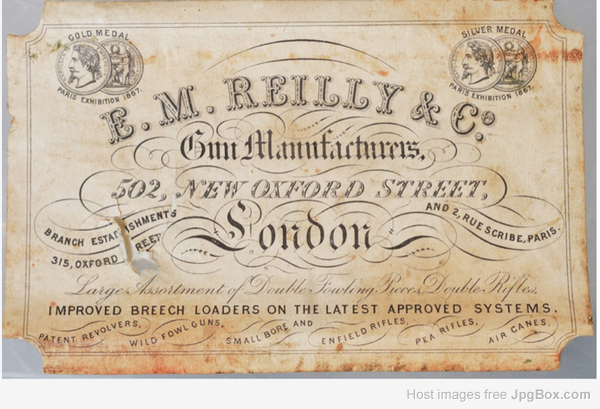
-- Earliest London Newspaper ad for Reilly with the Paris address (they trumpted their medals at the 67 Paris fair from August 1867 on) is this one; as of end of October 1867, no Paris address in his ads. PALL MALL GAZETTE, London, 12 Feb 1868: E. M. REILLY and CO., 502 NEW OXFOD STREET, London. Branch Establishments- 315, Oxford-street, London ; and 2, Rue Scribe, Paris
1870 - Trials: Trials to replace the Snider by British Army, Reilly enters a Belgian Comblain breech loader with his name on it. No Paris address but Paris is stamped on one butt on Comblain nr. 32, probably a trial gun.
1871 - Martini Henry (Martini action, Henry barrel) adopted by British Army. (See Reilly SN 17644) It was used until 1892 when the Lee-Medford then Lee-Enfield was adopted and continued to be entered in marksmanship contests until WWI. Reilly made Martini Henry’s for the next 30 years in various calibers. The first Reilly Martini Henry I can find is SN 17644 (and I can't be sure it's really a Reilly SN). (I do not believe he place Reilly SN's on many subsequent Martini orders though he put his name on them..17644 is the only Reilly SN I can find - and the SN may not be his).
On 13th April 1871 the orders were placed at the Royal Small Arms factory at Enfield for full scale production of the Martini Henry Rifle, between then and 1874 The Martini Henry was trialled throughout the Empire by various regiments, and finally on September 28th 1874 it was authorised for full issue to the British Army. (Mark I-IV variants - this was the gun of Rork's Drift, the Zulu Wars; the Second invasion of Afghanistan in 1878 - used by British Regiments, etc).
1871 - Advertisement in Statesman’s Yearbook, 1871:
E. M. REILLY and CO.,
GUN MANUFACTURERS,
502 New Oxford Street, London.
BRANCH: 2 RUE SCRIBE, PARIS.
1871 - American catalogue: 1871 J. H. Johnston Great Western Gun Works catalog:
Muzzle loader = sold as ‘English’, ‘Belgian’, ‘American’, only Greener is called out by name
Breech loader = Greener, Westley Richards, E. M. Reilly & Co
1870-1880 - Advertisements in Bradshaw Illustrated travel books.
E.M. Reilly & Co of 502, Oxford Street, London, branches 315, Oxford Street, London and 2, Rue Scribe, Paris
1870 - Advertisement, “Bradshaw’s Pedestrian Route Book for Switzerland, Chamouni and the Italian Lakes.” 502 and 315 Oxford Street and Rue Scribe addesses. It mentions: Sole manufacturers of the Reilly-Comblain rifle for military and sporting purposes (see Reilly-Comblain entries below in the SN thread)
1872 - Patent: Anson's fore-end fastener patent no. 3791
1874 - Patent: Needham patented a hammerless, barrel-cocking gun which was also the first ejector in 1874.
1875 - Patent: W.M. Scott's patent 3223
1875 - Patent: Anson & Deely patent; the first hammerless gun with top lever.
1878 - Patent: Mills 3rd bite patent no 4980
1878 - Patent: Patent Number 761 was recorded by William Middleditch Scott and Thomas Baker
1878 - Exhibition: Paris Exhibition
1881-1891: Reilly guns dominate pigeon shooting contests in England and abroad,
1881 - Address: Late in 1881 Oxford street was re-numbered - 315 becoming 277 and 502 becoming 16. Reilly used both numbers along with Rue Scribe in advertisements in 1882. Theoretically guns after 1881 ought to have 16 Oxford or 277 Oxford along with the Rue Scribe Paris address. However, some guns apparently continued to be labeled with the 502 and 315 Oxford Street numbers. (see 1882 advertisement below)
1882 - January, Advertisement: Royal Red Book of Court and Fashionable Register for January
EM REILLY & CO.
277 (315), Oxford St., W; 16 (502) New Oxford St.[/color],
and Rue Scribe, Paris
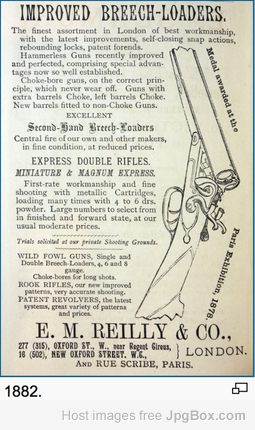
1883 - Advertisement; Army Navy Calendar for the Financial Year1883-84 (Note continued use of the 315 and 502 addresses)
Advertisement for EM Reilly,
IMPROVED BREECH LOADERS
located at 315 and 502 Oxford Street, London and Rue Scribe, Paris
1883 - Exhibition: Calcutta, 1883. Silver medal prize.
1884 - Prize: Awarded a Gold Medal in the London Exhibition.
1885 - Exhibition: "Messrs. Reily & Co.’s stand at the International Inventions Exhibition of 1885 was acknowledged to have been one of the best-appointed exhibits. Express rifles formed an important part in this display. the double 450-bore and 500-bore with long cartridge and 120 grains of powder, and the 400-bore with 90 grains of powder, were much admired and considered equal to the work required of them, viz, deer-stalking, black buck, etc. Amongst the exhibits were Magnum Express 577, and large bore rifles, 12, 10, 8, and 4 gauge, single and double barreled, of the latest construction, taking heavy charges of powder, as supplied to well-known hunters and explorers in Africa, India and other parts of the world. Rook and rabbit rifles of 300-bore, with hammers and hammerless. The shooting these small bores - either single or double barrel - rifled on their non-fouling system, is wonderfully accurate.” (Wyman)
“Messrs. Reilly also exhibited self-ejector hammerless guns, which throw out the exploded cartridge case or cases as may be… This gun has the automatic safety bolt and other recent improvements in hammerless guns."
1886 : Advertisement: Burke’s Landed Gentry publication shows premises at 277 Oxford Street, 16, New Oxford Street and Rue Scribe, Paris.
1886 - Address: Reilly closed Rue Scribe, Paris. (See Reilly SN 26584). Some claim he opened another office in St Honore. I doubt this. The address is for a hotel. Perhaps he kept a mailing address there. - I'm not denigrating others' research...I just can't find the references...please add to this if you know more.
The last SN I can find with Oxford St. and Rue Scribe. It's on a label in my case. The SN is 26584 and there is a date 1886 in the corner, hand written:

1887 - Proof Mark: “Not for Ball” proof mark dropped.
1889 - Southgate lockwork, ejector and interceptor sear patent no 12314.
1889 Jun - 1890 Feb: Law suit re easement to the entrance way to 277 New Oxford Street. Reilly v. Booth. Cited in land law cases for the next 100 years:
https://books.google.com/books?id=lTIyAA...don&f=false1890 - Personal: EM Reilly dies. Business taken over by his sons Charles E. Reilly (b1871) and Herbert (Bert) H. Reilly (b. 1875)? Who ran the business since these boys were 19 and 16 years old at the time? Mary, the wife?
1893 - Patent: Southgate's ejector trip patent no 8239
1898 - Address: 16 New Oxford Street closed. (See Reilly SN 34723); 277 New Oxford Street remains open.
1903 - Registration: Charles Arthur Farquhar Reilly (b1870) & Herber Horace (Bert) Reilly listed at 277 Oxford Street, London in electoral roles.
1903 - Address: 277 New Oxford Street vacated - moved to 295 Oxford Street. (See Reilly SN 35423)From 1904 to 1911 the firm was recorded at 295 Oxford Street. According to oft repeated information, A gun built c1905 also carries his late father’s address of 12 Middle Row, Holborn on the top rib. I've seen bad information repeated ad nauseam and become "history." Middle Row was destroyed and the Prudential building built there in the late 1800's. Before accepting this, I'd like to see the gun and the serial number.
In 1912 E M Reilly & Co Ltd was recorded at 13 High Street, Marylebone. The directors of this limited company were H Reilly and C W Roberts. I've attempted to establish the identity of CW Roberts...no success so far. Welcome additional information. (see page 15: CW Roberts is likely George W. Roberts, liquidated who handled the bankruptcy of Reilly on June 8, 1912.)